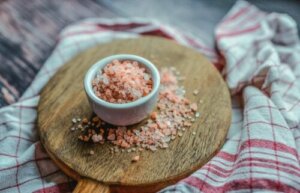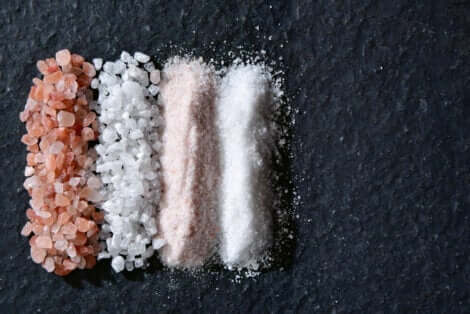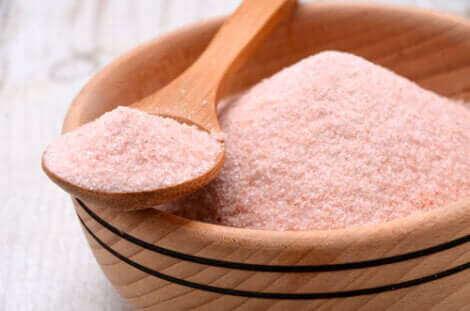The Ten Health Benefits of Pink Himalayan Salt: Fact or Fiction?


Reviewed and approved by the pedagogue in physical education and nutritionist Elisa Morales Lupayante
Pink Himalayan salt is a mineral ingredient that comes from the mountains of Pakistan, more specifically the Khewra salt mine. It’s become increasingly popular in recent years, due to the fact that many have attributed numerous health benefits to it.
In fact, some consider it “the purest salt on the planet”, and claim that it’s much healthier than traditional table salt. But how true is this? Can it actually help improve health? Below, we detail its main properties and answer these questions.
What’s pink Himalayan salt?
As we already mentioned, pink Himalayan salt is a type of pink-colored salt that’s mined from a salt mine near the Himalayas. Its defenders point out that it’s one of the purest salts on the planet. However, these claims have been questioned.
In fact, a study published in Science-Based Medicine states that its color is due to impurities. The reason? In its natural state, pure sodium chloride is white. Therefore, it’s ironic to state that it’s the purest salt when its color says otherwise.

Speaking of sodium chloride, we should mention that it’s the main component of Himalayan salt. Also, it contains about 84 trace minerals, which is precisely why it’s said to be a healthier salt.
Nevertheless, this has also been questioned, and even denied, by some experts. As a matter of fact, according to the aforementioned study, many of these minerals are in barely detectable amounts.
Furthermore, to date, only 15 minerals are known to play important roles in biological processes, while seven are considered “possibly essential, but not confirmed”.
Thus, the presence of all these trace minerals isn’t a reason to claim that this salt is “super healthy”. In fact, some of those it contains, such as mercury, arsenic, lead, and thallium, are actually harmful, although they’re found in this product in minimal quantities.
You might be interested to read: Which types of salt are the healthiest?
Does Himalayan salt have ten health benefits?
Since its rise in popularity, pink Himalayan salt has been credited with ten health benefits. Its distributors were even charged with selling it as a “curative” product that can improve health and quality of life.
Although there’s no scientific evidence on these benefits, pink Himalayan salt is said to:
- Fight fluid retention.
- Regulate blood pH.
- Increase nutrient absorption.
- Boost energy levels.
- Improve vascular health.
- Reduce high blood pressure.
- Fight migraines.
- Calm muscle cramps.
- Detoxify the body.
- Promote healthy sleep patterns.
However, nutritionists and scientists have managed to disprove many of these claims.
For instance, Ramón de Cangas, dietician-nutritionist, a doctor in molecular and functional biology, and a member of the Spanish Academy of Nutrition and Dietetics explained to the newspaper, El País from Spain that pink Himalayan salt “Provides the same amount of sodium as table salt”.

According to this expert, the daily sodium intake recommendations established by the World Health Organization (WHO) are applicable to this product. In other words, as with traditional salt, you shouldn’t consume more than five grams per day. That’s the equivalent of a teaspoon of coffee.
Excessively consuming this salt, like any other source of sodium, has a series of health risks that go beyond high blood pressure. This was confirmed in a study published in the Journal of the American College of Cardiology .
A matter of marketing
Despite the popularity of pink Himalayan salt and its supposed benefits, there’s no evidence to suggest it’s healthier than normal table salt. There’s also no complete guarantee of its “purity”. Indeed, its popularity is mostly due to marketing, not science.
Therefore, investing in this type of salt could entail more expenses than benefits. That’s because, apart from the fact that it’s much more expensive than traditional salt, it should be consumed with caution.
All cited sources were thoroughly reviewed by our team to ensure their quality, reliability, currency, and validity. The bibliography of this article was considered reliable and of academic or scientific accuracy.
- Chander, V., Tewari, D., Negi, V., Singh, R., Upadhyaya, K., & Aleya, L. Structural characterization of Himalayan black rock salt by SEM, XRD and in-vitro antioxidant activity. Science of the Total Environment. 2020; 748: 141269.
- Farquhar WB, Edwards DG, Jurkovitz CT, Weintraub WS. Dietary sodium and health: more than just blood pressure. J Am Coll Cardiol. 2015;65(10):1042–1050. doi:10.1016/j.jacc.2014.12.039
- Fayet-Moore F, Wibisono C, Carr P, Duve E, Petocz P, Lancaster G, McMillan J, Marshall S, Blumfield M. An Analysis of the Mineral Composition of Pink Salt Available in Australia. Foods. 2020 Oct 19;9(10):1490.
- Harriet Hall, MD. Pink Himalayan Sea Salt: An Update. 2017.
Available in: https://sciencebasedmedicine.org/pink-himalayan-sea-salt-an-update/ - Tan, W. L., Azlan, A., & Noh, M. F. M. (2016). Sodium and potassium contents in selected salts and sauces. International Food Research Journal, 23(5), 2181–2186.
- El País. Las mentiras de la sal rosa de moda: ni es tan beneficiosa ni viene del Himalaya. (2018).
- FDA. Sodium in Your Diet. (2021).
This text is provided for informational purposes only and does not replace consultation with a professional. If in doubt, consult your specialist.








